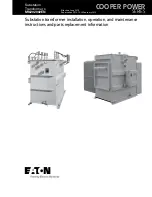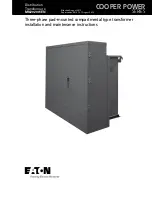
AC5124-10 Specifications
AC5124-10 Specifications
AC5124-10 Specifications
AC5124-10 Specifications
11/24/03
40
7.1.3
7.1.3
7.1.3
7.1.3
Channel
Channel
Channel
Channel
EEPROM Address: 2Eh
Length: 1 Byte
Default: 00h
Range: 00h
–
4Ch
Provides 77 unique and non-interfering pseudorandom hopping sequences or Channels. This allows
the OEM to configure up to 77 independent, co-located data networks. The combination of the
Channel and System ID must be unique to each network of transceivers to establish communication.
Here are some examples:
•
Network A: Channel – 05h, System ID – 01 02 03 04 05 06 07 08
•
Network B: Channel – 4Ah, System ID – 11 22 33 44 55 66 77 88
Multiple Servers in the same coverage area must be programmed with different Channels to prevent
inoperability of the networks.
It is highly recommended that the OEM change the Channel and System ID from their default values.
7.1.4
7.1.4
7.1.4
7.1.4
Transmit Attempts
Transmit Attempts
Transmit Attempts
Transmit Attempts
EEPROM Address: 2Fh
Length: 1 Byte
Default: 10h
Range: 01h
–
FFh
This parameter specifies the maximum number of times a packet will be transmitted over the RF
interface. A transceiver operating in API Mode will reply with a
Send Data Complete
Send Data Complete
Send Data Complete
Send Data Complete
command (with a
Failure Code = 1) when the maximum transmits has been attempted without success. Transceivers
operating in any of the Transparent Modes will not send an acknowledgement to their Host.
7.1.5
7.1.5
7.1.5
7.1.5
Receive Mode
Receive Mode
Receive Mode
Receive Mode
EEPROM Address: 31h
Length: 1 Byte
Default: 03h
Range: 01h
–
03h
There are 3 different interface receive modes. When a transceiver receives a data packet over the RF, it
must determine if the packet is addressed to it or another transceiver on the network. Receive mode
specifies the criteria a transceiver uses for validating a data packet. When the transceiver is operating
in any Transparent Mode, Receive Mode must be set to a value of 03h (Promiscuous).
7.1.5.1
7.1.5.1
7.1.5.1
7.1.5.1
Unicast/Broadcast (01h)
Unicast/Broadcast (01h)
Unicast/Broadcast (01h)
Unicast/Broadcast (01h)
Unicast/Broadcast Mode is only valid for transceivers operating in API Mode. Transceivers will receive
packets that have matching IEEE 802.3 destination addresses and broadcast packets. Broadcast
packets will have a destination address equal to FF FF FF FF FF FF. It is important to note there are no
RF acknowledgements for Broadcast packets. All other packets will be discarded.















































